Physical Address
304 North Cardinal St.
Dorchester Center, MA 02124
Congenital coronary artery (CA) anomalies (CAAs) encompass a diverse spectrum of pathology. They include both benign variations in CA anatomy as well as patterns that predispose to sudden cardiac death (SCD). Broadly speaking, congenital CA anomalies include abnormalities in ( ) CA origin, ( ) CA course or distribution, and ( ) CA termination (fistulae). This chapter focuses on the echocardiographic evaluation of anomalous CA origin with special attention to anomalous coronary artery origin from the opposite sinus (ACAOS) of Valsalva.
ACAOS has particular clinical importance because it has been associated with SCD in asymptomatic healthy young people. ACAOS is clinically meaningful when the proximal course of the CA travels between the aorta and pulmonary artery (PA) (interarterial course). The prevalence of ACAOS with interarterial course is unknown and varies widely across reports (0.17%–1%) depending on the population studied and the imaging modality used. , Additional risk factors for sudden death are thought to include narrow (“slitlike”) orifice of the anomalous CA, intramural course, and dynamic compression of the CA seen on angiography.
Accurate diagnosis of ACAOS by transthoracic echocardiography (TTE) is possible but depends on suitable acoustic windows, a protocol that is optimized for CA anatomy and highly trained sonographers. In children and thin, young adults, two separate CA ostia can be seen approximately 90% of the time using two-dimensional (2D) TTE with color Doppler, thereby excluding most important CA anomalies. , However, false-negative studies have, on rare occasion, preceded SCD.3 In selected patients, transesophageal echocardiography (TEE) can also identify CA ostia when TTE is inadequate, but increasingly, cross-sectional imaging with computed tomography (CT) or magnetic resonance imaging (MRI) is being used for definition of CA and distribution.
Although the definition of a CAA is debated, one classification scheme by Angelini , , defines CAA as an anatomic variation occurring in fewer than 1% of the population. Although many types of CAAs have been described ( Table 47.1 and Fig. 47.1 ), few are clinically significant. The majorities of CAAs are clinically silent and remain undetected, so the prevalence of CAAs remains uncertain. This uncertainty is compounded by nonstandard definitions of what constitutes a coronary anomaly; differences in referral populations; and various imaging modalities including echocardiography, angiography, CT, and MRI.1 In a prospective case series of 1950 participants referred for angiography, Angelini and coworkers found CAAs in 5.64% of patients. The majority were benign, but 1.1% had ACAOS. Other authors using different modalities in dissimilar populations have found lower rates. Although the authors concede that their study is limited by referral bias, it does go to illustrate the relatively high prevalence of ACAOS, arguably the anomaly most strongly associated with SCD. ,
|
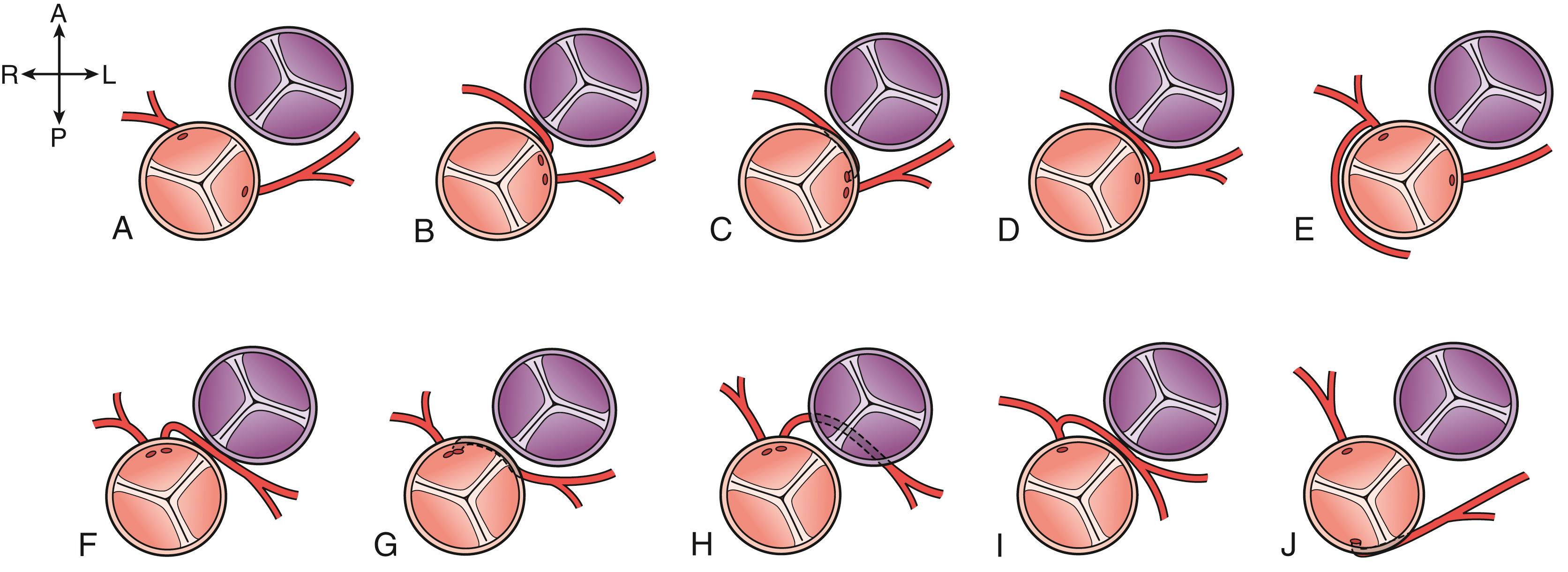
ACAOS is the most common CAA associated with SCD in young athletes , ( Figs. 47.2 and 47.3 ; ![]() ). Although both anomalous right coronary artery (RCA)and left coronary artery (LCA) have been described with ACAOS, the presence of an ectopic LCA originating from the right sinus of Valsalva appears to be higher risk. The mechanism of SCD in athletes with ACAOS is not certain. It has been observed that SCD appears to be limited to patients with an interarterial course, and those with an intramural course appear to be at highest risk. For this reason, it has been speculated that vessel compression and resultant myocardial ischemia lead to SCD in young individuals. , , The often intramural nature and acute angle of takeoff of the anomalous artery have also been implicated in causing episodic ischemia in athletes undergoing significant physical exertion. , Indeed, controversy exists between which is more important: ( ) the CA coursing between the aorta and PA, ( ) the intramural course, particularly the length of intramural course, or ( ) the degree of acute angle takeoff. In a review of two large registries of SCD in young competitive athletes, 27 cases have been attributed to autopsy findings of ACAOS. The authors found that in all of these cases, the athletes died either during or after intense physical exertion; furthermore, 12 of the athletes (45%) experienced premonitory symptoms such as syncope or chest pain in the days to months leading up to their terminal event. Importantly, none had evidence of myocardial ischemia with treadmill stress testing. This study highlights the importance of considering ACAOS in competitive athletes presenting with exertional chest pain with normal cardiac examination and electrocardiogram findings. It also highlights the limitation of stress testing for making this diagnosis. With early detection, these athletes can be excluded from competitive sports to reduce their risk of SCD until definitive correction. Oddly, however, some victims of sudden death have been competitive athletes in their younger years and experienced sudden death at a later age.
). Although both anomalous right coronary artery (RCA)and left coronary artery (LCA) have been described with ACAOS, the presence of an ectopic LCA originating from the right sinus of Valsalva appears to be higher risk. The mechanism of SCD in athletes with ACAOS is not certain. It has been observed that SCD appears to be limited to patients with an interarterial course, and those with an intramural course appear to be at highest risk. For this reason, it has been speculated that vessel compression and resultant myocardial ischemia lead to SCD in young individuals. , , The often intramural nature and acute angle of takeoff of the anomalous artery have also been implicated in causing episodic ischemia in athletes undergoing significant physical exertion. , Indeed, controversy exists between which is more important: ( ) the CA coursing between the aorta and PA, ( ) the intramural course, particularly the length of intramural course, or ( ) the degree of acute angle takeoff. In a review of two large registries of SCD in young competitive athletes, 27 cases have been attributed to autopsy findings of ACAOS. The authors found that in all of these cases, the athletes died either during or after intense physical exertion; furthermore, 12 of the athletes (45%) experienced premonitory symptoms such as syncope or chest pain in the days to months leading up to their terminal event. Importantly, none had evidence of myocardial ischemia with treadmill stress testing. This study highlights the importance of considering ACAOS in competitive athletes presenting with exertional chest pain with normal cardiac examination and electrocardiogram findings. It also highlights the limitation of stress testing for making this diagnosis. With early detection, these athletes can be excluded from competitive sports to reduce their risk of SCD until definitive correction. Oddly, however, some victims of sudden death have been competitive athletes in their younger years and experienced sudden death at a later age.
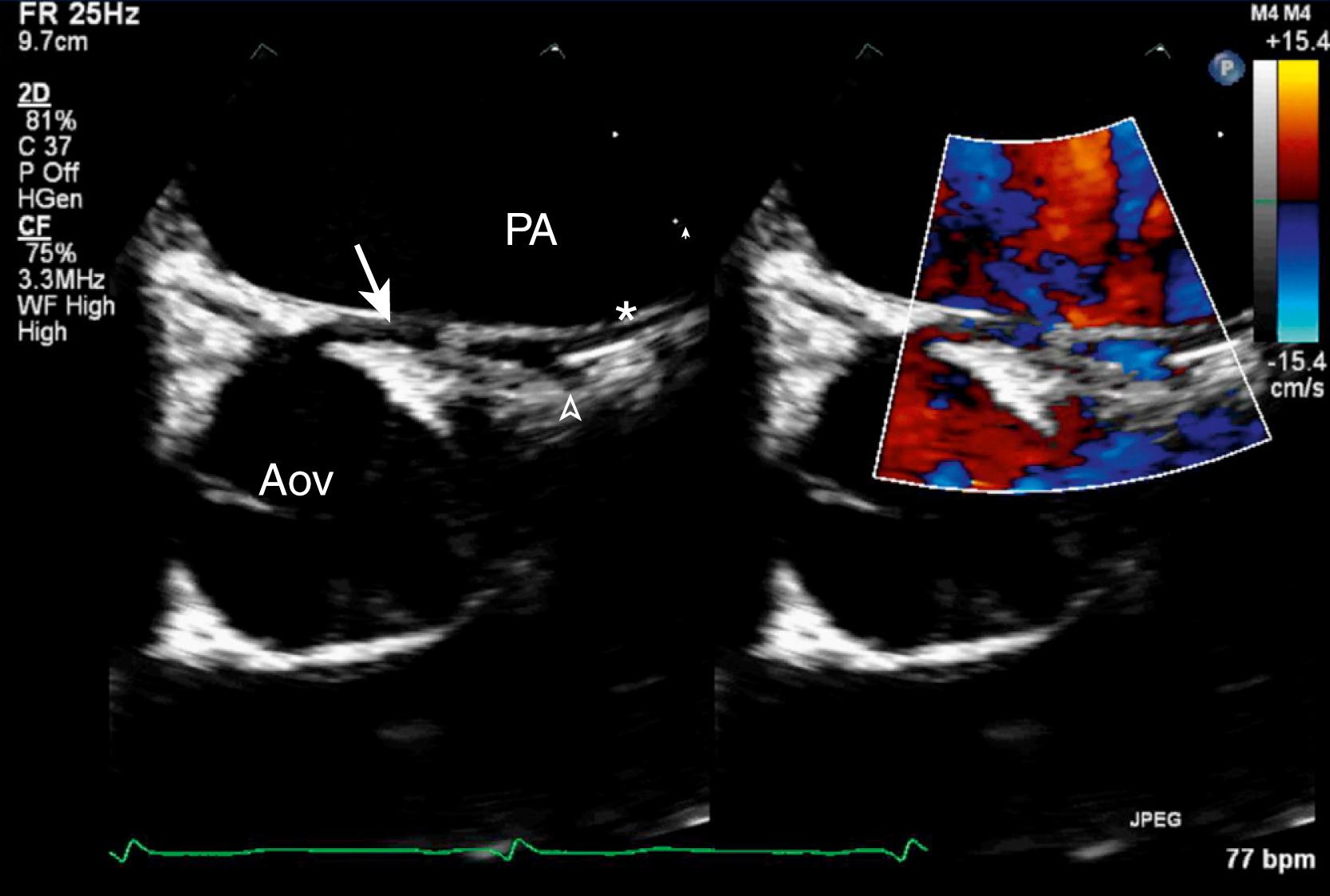
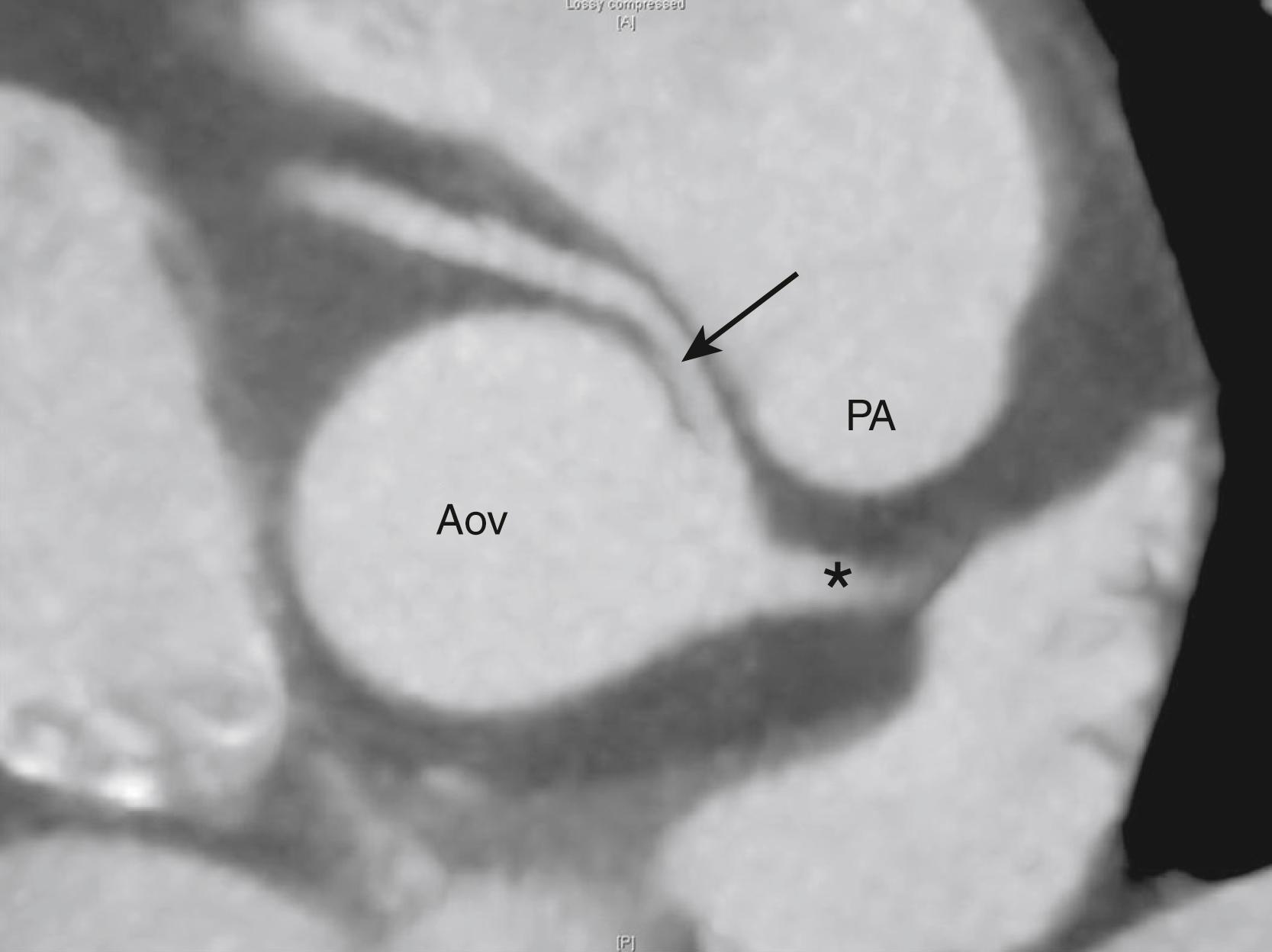
Video 47.2. Parasternal short-axis at the level of the sinuses of Valsalva with two-dimensional and color Doppler. This shows anomalous origin of the left coronary artery from the right sinus of Valsalva.
Another CCA involving abnormalities in CA origin is anomalous origin of the right or left CA from the pulmonary artery (ALCAPA or ARCAPA) ( Figs. 47.5 to 47.7 ; ![]() , , , ). ALCAPA typically presents with heart failure in infancy. Invariably, the CA with normal origin from the aortic root is dilated. The anomalous coronary is perfused retrograde from collaterals and drains into the PA. The most common variant of this anomaly, in which the LCA originates from PA (ALCAPA, or Bland-White-Garland syndrome), can cause chronic myocardial ischemia caused by the LCA blood supply having decreased perfusion pressure and oxygenation because of its PA source; the presence of collateralization can also lead to coronary steal with left-to-right shunting. In a small proportion of patients with ALCAPA, robust collaterals provide adequate myocardial blood flow and delay presentation until adolescence or adulthood. They may present with ventricular arrhythmias, cardiomyopathy, ischemic mitral regurgitation, or SCD as a result of chronic left ventricular subendocardial ischemia. ARCAPA generally has a more favorable prognosis.
, , , ). ALCAPA typically presents with heart failure in infancy. Invariably, the CA with normal origin from the aortic root is dilated. The anomalous coronary is perfused retrograde from collaterals and drains into the PA. The most common variant of this anomaly, in which the LCA originates from PA (ALCAPA, or Bland-White-Garland syndrome), can cause chronic myocardial ischemia caused by the LCA blood supply having decreased perfusion pressure and oxygenation because of its PA source; the presence of collateralization can also lead to coronary steal with left-to-right shunting. In a small proportion of patients with ALCAPA, robust collaterals provide adequate myocardial blood flow and delay presentation until adolescence or adulthood. They may present with ventricular arrhythmias, cardiomyopathy, ischemic mitral regurgitation, or SCD as a result of chronic left ventricular subendocardial ischemia. ARCAPA generally has a more favorable prognosis.
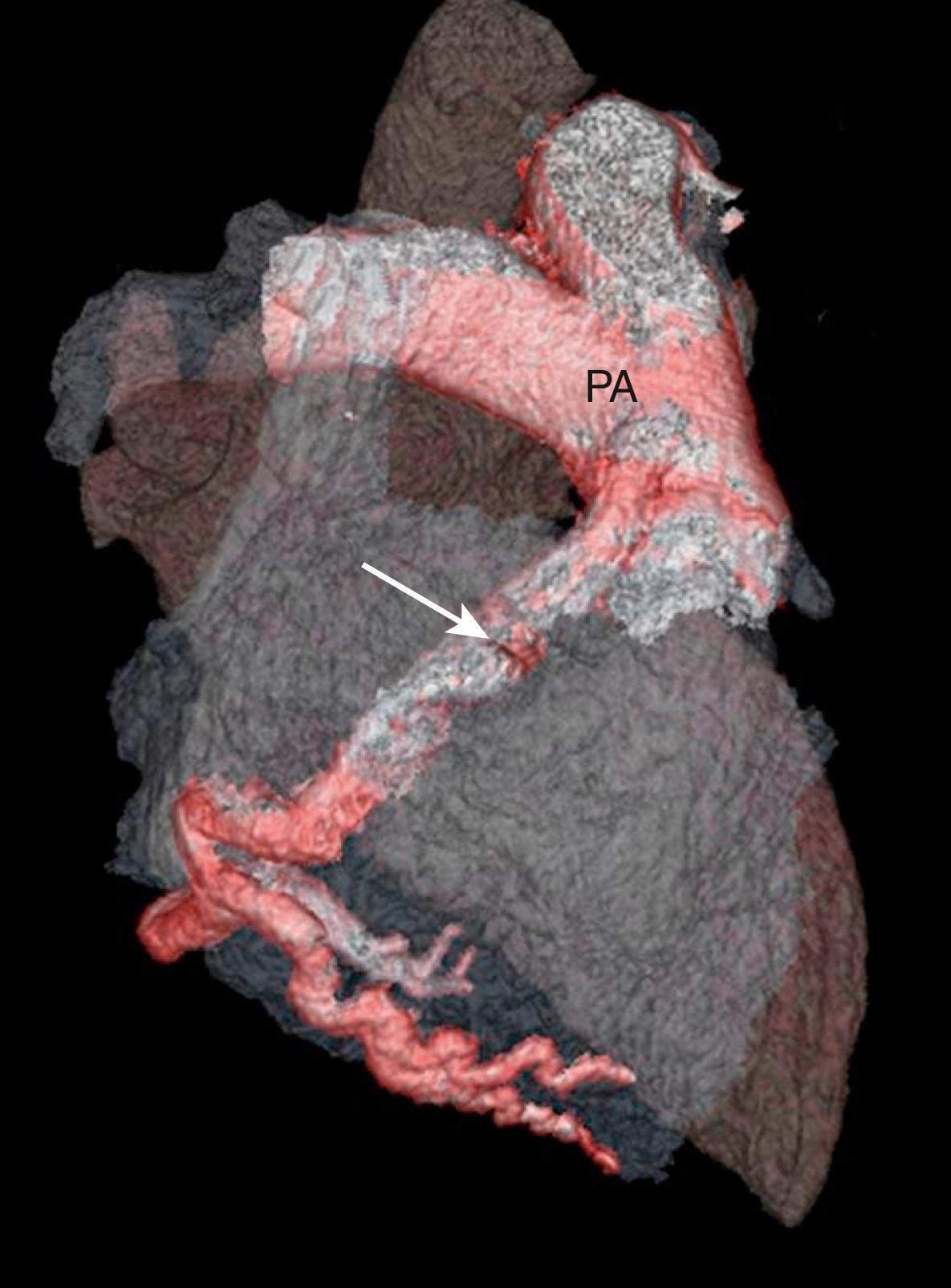
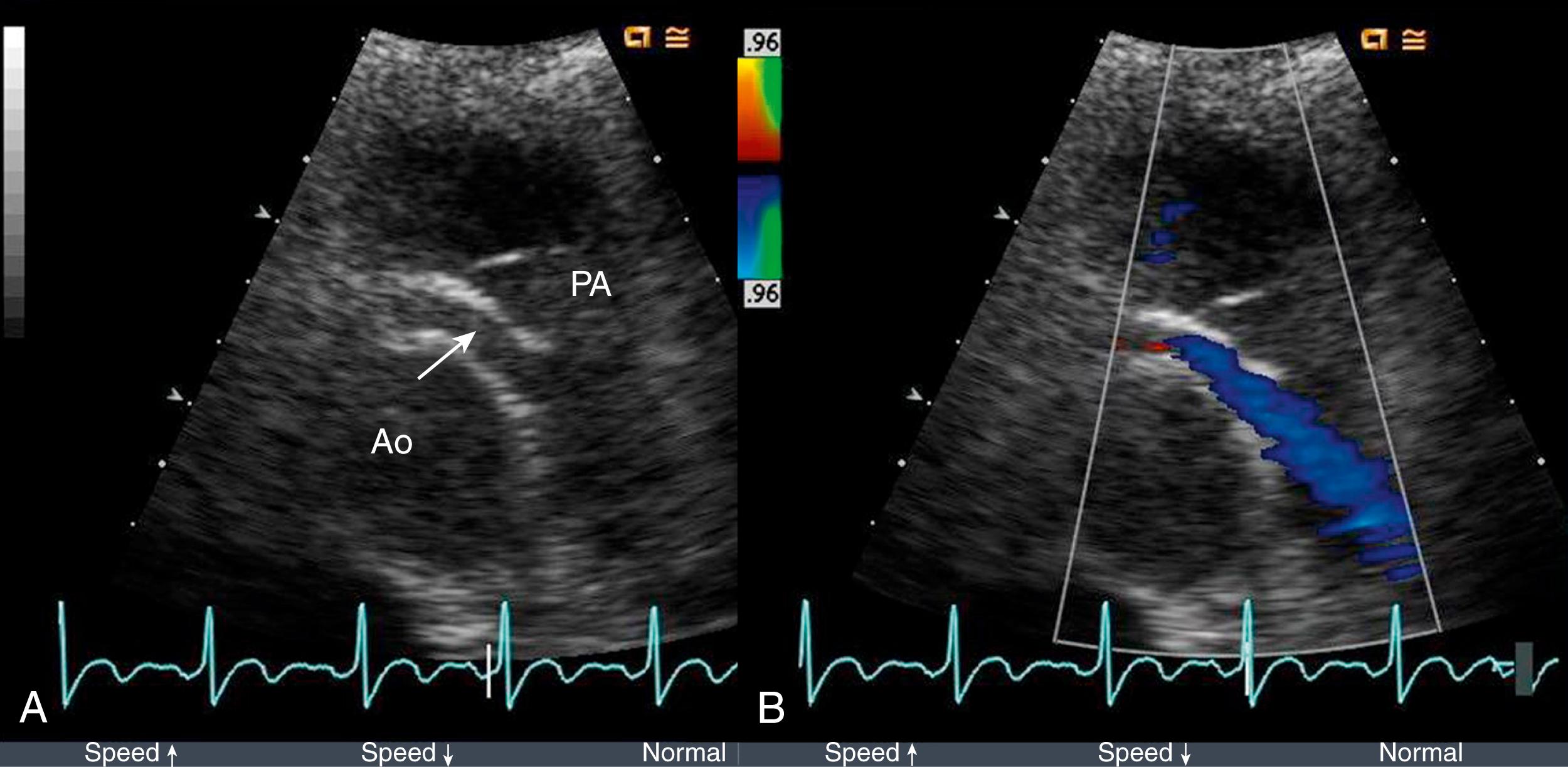
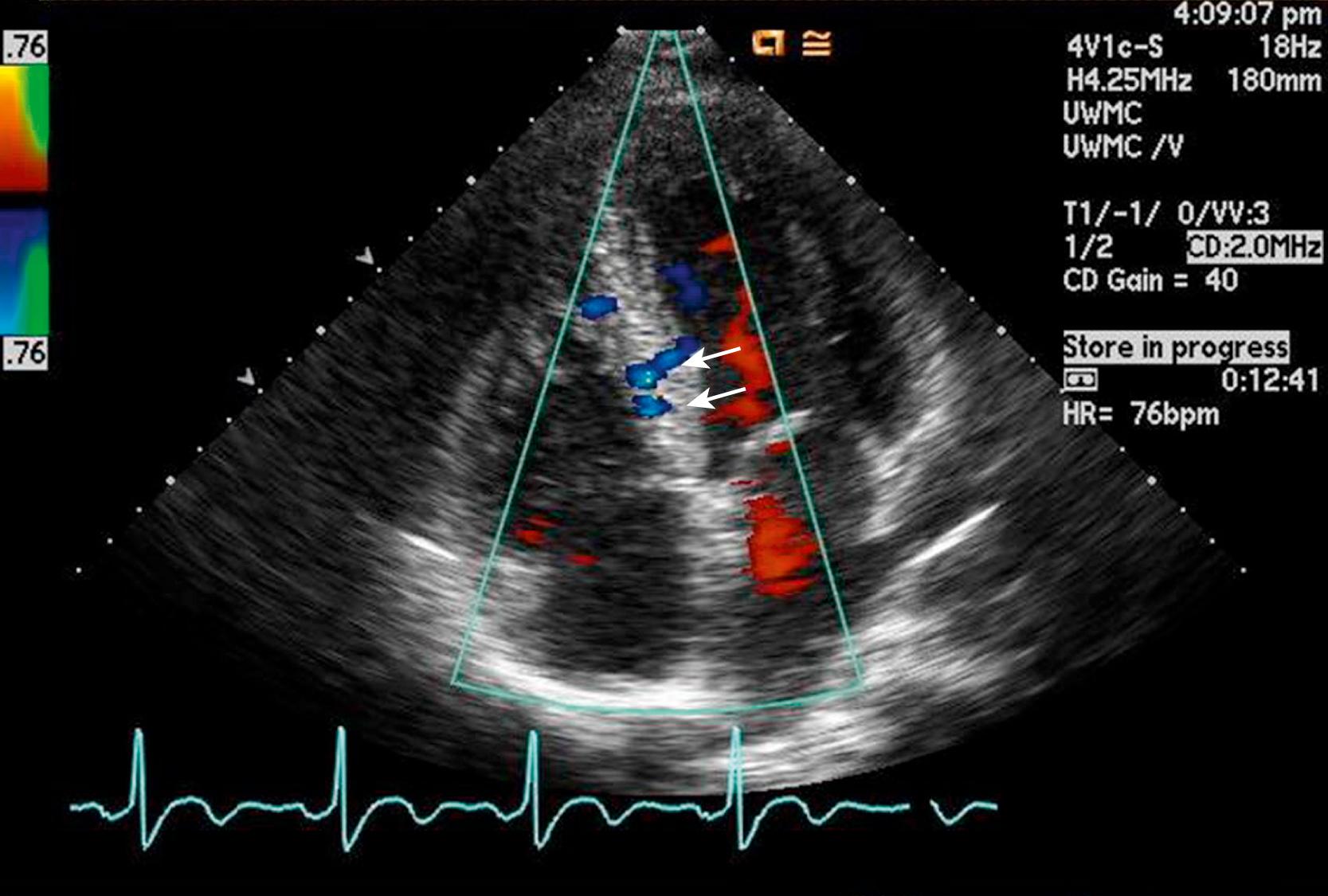
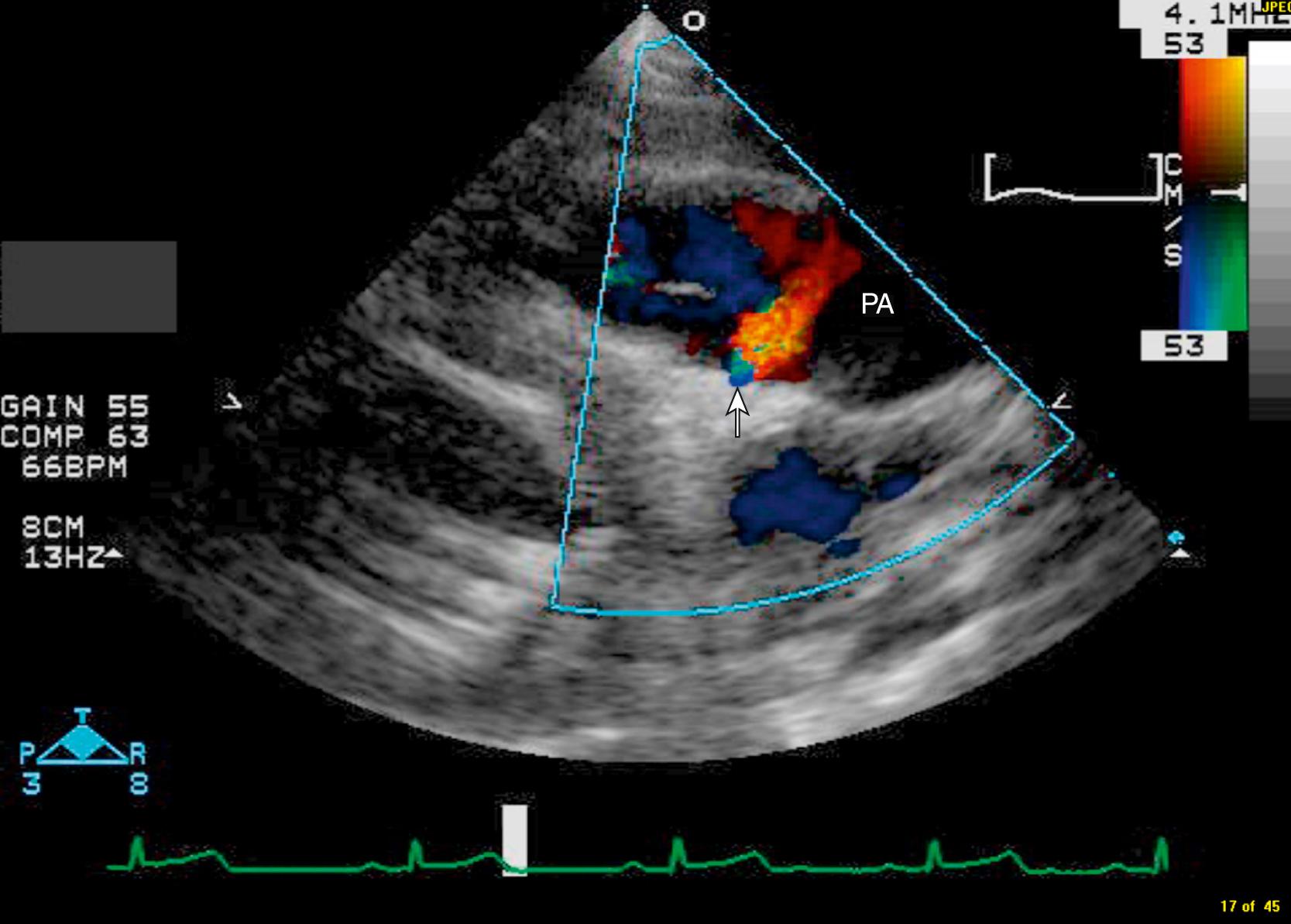
Video 47.5. Color Doppler echocardiogram showing anomalous right coronary artery from the pulmonary artery (ARCAPA). Note the anomalous coronary artery is perfused retrograde via collaterals from the left coronary artery and drains into the pulmonary artery.
Video 47.6. Color Doppler shows anomalous left coronary artery from the pulmonary artery (ALCAPA).
Video 47.7. Parasternal long-axis view at the level of the pulmonary valve and pulmonary artery showing the takeoff of the left main coronary artery (orange jet) from the pulmonary artery. B is similar to A except demonstrating a sweep from pulmonary artery to aorta showing the left coronary artery arising from the pulmonary artery, not the aortic sinus of Valsalva.
A multitude of imaging techniques are used to detect, characterize, and potentially predict the prognosis of the known major anomalies. Coronary angiography with or without intravascular ultrasound (IVUS) has been the mainstay and can be useful for definitive diagnosis in symptomatic patients or patients with an aborted sudden death, though is not clearly acceptable as a screening tool given its invasive method, cost, and inherent risk. Computed tomography angiography (CTA) offers clear spatial resolution, but it brings with it the risk of ionizing radiation and contrast in young patients. Cardiac magnetic resonance imaging (CMRI) is particularly attractive because of its lack of radiation and is also optimal for anatomical definition, though cost, time, noise, and claustrophobia are downsides. Furthermore, the ability of CMRI to assess for collateral vessels, coronary fistulas, or coronaries originating from the ventricle or PA is limited. Transthoracic echocardiography (TTE) and to a lesser extent transesophageal echocardiography (TEE) are imaging techniques with significant research history and clinical use for detection of CAA, particularly TTE for screening and TEE for more detailed confirmation of CA course. Both modalities are advantageous because of absence of radiation and widespread availability and TTE for its very noninvasive nature.
Become a Clinical Tree membership for Full access and enjoy Unlimited articles
If you are a member. Log in here